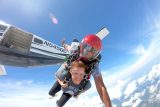4 Secret Skydiving Facts
General
Posted by: Long Island Skydiving Center
8 years ago
Did you know that skydiving has a few secrets? One of the coolest things about the sport is that there’s so much more to skydiving than meets the eye. Here are a few fun skydiving facts you can use to impress your friends. (We’re pretty sure they’ll be amazed.)
1. Even If Nobody Touches It, the Reserve Parachute Can Deploy Itself.
Every LISC tandem skydiving rig (and pretty much every smart sport skydiver’s rig) has a little bit of magic attached: an AAD, or automatic activation device. The AAD is a little gizmo that identifies descent rate and altitude in real time, checking to see if the main parachute has been deployed by the critical altitude. If it hasn’t, the AAD cuts the reserve loop, deploying the reserve parachute no matter what, even without any human input. Doesn’t that feel good to know?
2. The Reserve Parachute is Treated as Sacred.
The FAA requires that every skydiving reserve parachute is inspected and repacked every 180 days–whether it has been used or not. Each time it’s done, the FAA-certified rigging professional that does the job has to sign off on it and close the container with a little metal seal bearing his or her initials. If a skydiver shows up to a dropzone and that little seal of responsibility is missing, the jumper is not allowed to jump that rig.
3. The Person in the Driver’s Seat is Something of a Superhero.
The skills used by a pilot at a skydiving center are quite specialized. There are few flying gigs on the planet that require a pilot to spend about 95% of the flight in the climb to altitude, first of all (as the getting-down is a heck of a lot quicker in the empty plane). Jump pilots are also required to fly a very specific pattern over the dropzone in order to let jumpers out at exactly the right spot, adjusting for wind drift and other conditional contingencies.
But wait! There’s more. Pilots manage the weight balance of a jump plane, which changes constantly as jumpers move; the slow flight during the exit process, which is a balancing act; the constant takeoffs and landings. They’re not only trained for “normal” aircraft emergencies like engine failures, forced landings, stalls, spins and the like, but for the even more extremely unusual issues that can occur during skydiving operations (such as parachutes accidentally deploying inside the plane). The job isn’t easy, so make sure to give your pilot a solid fistbump if you see him/her on the ground.
4. …And so Are the Tandem Instructors.
Tandem skydiving instructors are rigorously trained and super-dedicated pros. There’s an absolute minimum of 500 jumps and three years in the sport, as well as a set of medical requirements and a bunch of proficiency testing, both in the classroom and in the sky.
Once that rung is reached, the true training begins. Each tandem skydiving rig manufacturer has an equipment-specific program that certifies the skydiver to expertise on that particular equipment. Beyond that, tandem instructors are generally mentored in the kind of customer support that this dynamic, highly emotionally charged activity requires.
When you come down to make a tandem skydive, take a few minutes to watch them work. They make it look easy, but there’s a lot to the job! Great tandem instructors (like ours) don’t mind, because they love what they do–and they’ll always find time to celebrate that successful skydive with you. (High fives are part of the job description!)
Bonus Secret:
Did you know a professional actually did a skydive WITHOUT a parachute?
Categories:
You May Be Interested In:

Is A Skydiving Proposal A Good Idea?
4 months ago by Long Island Skydiving Center

Skydiving For Couples: Fun Date Activity In NYC
4 months ago by Long Island Skydiving Center

Where Can I Go Skydiving in New York?
6 months ago by Long Island Skydiving Center

What Is A Skydiving Landing Like?
6 months ago by Long Island Skydiving Center